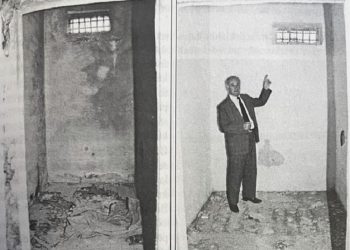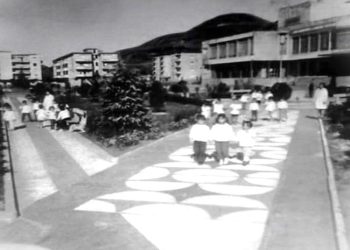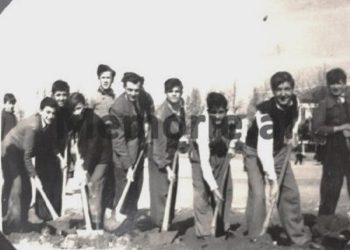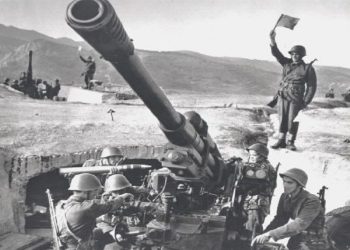Memorie.al publishes two rare testimonies of the last people who fled West German territory. These escapes took place in the final months of the Berlin Wall, where thousands would be East Berliners who over the years would undertake bold acts of crossing the border into the Western world, endangering the lives of them. Many succeeded, while many others did not. The cases, published in the British prestigious The Independent, present the spicy stories of Hans Peter Spitzer and Mario Wachtler, who were the last in the line of thousands within the natural boundary of a nation…
In the summer of 1989, few people doubted that East Germany was a few weeks away from collapsing. So in Berlin, Hans-Peter Spitzner was ready to risk his life and that of his daughter to flee beyond the Wall. And to the north, Mario Wächtler was preparing, for a 20-mile swim through the Baltic…
At first, there was some unbelief. It soon gave way to the wild jubilee and tears of unlimited, utterly unexpected joy. The fall of the Berlin Wall, 30 years ago, changed our world: it ended the Cold War and remains Europe’s most seismic political event since World War II. It fell just minutes past midnight on November 9, 1989. At the Bornholmer Strasse junction, East German border guards faced a large and increasingly angry mob of 20,000 East Berliners cheering, “Open the gate.” “. The guards feared for their lives. After trying to contact his supervisor, but without receiving any response, the responsible officer finally surrendered and ordered the barriers to be opened. “We are opening a flood now,” he announced. A human tide of East Berliners poured into West Berlin. Within the hour, the seven crossing points on the wall had been opened and a giant celebration was in full swing on the streets of West Berlin.
The fall of communism in Europe had begun. The wall was a monster and at the same time, the worst advertisement of Communism since its inception. It was a signal that East German socialism had failed. Before it was built in the early hours of August 13, 1961, more than 3.5 million East Germans had set out on foot for West Germany. That summer, East Germany did not even have enough farmworkers to bring in the harvest.
Many argue that the regime had to build the wall. Her only other option would be to acknowledge her moral, political, economic bankruptcy and resign. This was something the Kremlin was anxious to prevent at all costs. Western leaders, too, admit it: 1961 was the culmination of the Cold War. The wall stabilized an uncertain situation in Europe and kept track of the anticipation of a Third World War. It started out like barbed wire, then came the steel blocks, and then a 13-meter-high concrete barrier was fitted with a round pipe to make it difficult to scale. It was monitored at all times by Kalashnikov guards and equipped with watchtowers and searchlights. She besieged West Berlin, while her ugly sister – the border of the Iron Suburbs of East Germany – separated the communist state from Capitalist West Germany.
The wall acquired the stability of the Cold War at a cruel human price. There is no final balance of deaths, but according to the latest estimates, 718 people died either on the wall or on the German inner border, trying to escape to the West. Hundreds were shot dead, others suffered horrific injuries from firearms lined up at the border. The last person to die on the wall was 21-year-old East German Chris Gueffroy. He was shot in the heart by a border guard bullet as he tried to escape to West Berlin on February 5, 1989 – just nine months before the wall disappeared from history. The fall of the wall reunited the Germans and their families, but it came at a price.
Many East Germans still see their country’s subsequent reunification in 1990 as an example of capitalism at its worst. Tens of thousands lost their jobs as the collectivization of the communist state collapsed. Two million East Germans have migrated to the West since reunification, the vast majority looking for jobs (a migration that was halted only last year, when the numbers returned equaled those leaving) – resulting in dozens being abandoned. thousands of homes in the East. But among the East Germans who have tried the Berlin Wall period, there are very few who would want it again. Most praise the democracy they have won and taken pride in the fact that German Chancellor Angela Merkel is not only an Eastern like them but also one of Germany’s most popular leaders ever. For a whole new generation, the wall is just a story. Hans-Peter Spitzner – whose story is known as the last East German to cross the wall can be read in full. He claims that today’s reunited Germany is “the best Germany the Germans have ever had”.
Hans-Peter and Peggy Spitzner: The last people to cross the wall
At four o’clock in the morning at his gate, there was a series of loud beats that made Hans-Peter Spitzner realize that he had to flee East Germany. Naked and half asleep, he opened the gate to the two-room apartment in Karl-Marx Stadt. At the door were four people in civilian clothes. One uttered the words “home control”. The visitors were members of the Stasi secret police. Spitzner stood swinging in the bedroom as officers searched his apartment. He was told to dress, and to go to the back of a parked Lade, outside. They took him to the Stasi Headquarters. “I was paralyzed with fear and shock,” recalls Spitzner, now 60. “I didn’t know what was going on or what I should have done.” Spitzner was ordered to put a piece of cloth in his pocket. He would later learn that it was to allow sniffing dogs to recognize his smell. A bright lamp was pushed on his face. “After a minute or so, there was the only glitter,” he says. I stayed in the room for three hours. I checked, took pictures, and took my fingerprints. From that moment I realized that I would be under full surveillance. His crime? One teacher, Spitzner had surpassed the wall, all of his union colleagues. I knew I couldn’t continue to live like this, ”he says. “Something had to change. The question was, what? ” The answer, somewhat peculiar, was given by a communist newspaper. It described how soldiers from British, French and US allied forces stationed in West Berlin were allegedly “spying” outside East Germany.
Under post-war agreements, the Allies were allowed free access to the East. The paper claimed that they changed their Western brands for Eastern money at favorable rates and stripped East Berlin stores. The writer noted, in passing, that the cars of the Allied soldiers were not controlled by the Eastern authorities. “I thought, if the Allies could get household stuff, they could get people home,” Spitzner says. Peter and his wife Ingrid began to think seriously about escaping in July 1989. Then Ingrid was suddenly given permission to travel to Austria for her aunt’s 65th birthday. East German policy was flexible with regard to married people who traveled with children only because this could hold their families hostage.
Spitzner decided to escape with his daughter, and then meet Ingrid in the West. He did not say about his plan. He simply explained to Peggy that they would “meet Mom”. On August 16, 1989, Spitzner and Peggy traveled 120 miles to East Berlin. They spent the next two days hanging around the main bus station, begging drivers to take them west to their bus luggage compartment. “Everyone said it was very dangerous. By the end of day two, I was ready to head home when I noticed a black Toyota Camry with American license plates on my side mirror. An American soldier in uniform was watching us. ” The young soldier, Eric Yaë, took a few seconds to consider our proposal, before saying, “All right, I’ll do it.” Peggy climbed into the two-holder booth along with her dad. The two pressed together. “I just remember it was dark and hot. “I thought it was an adventure,” says Peggy, now 32. After 20 minutes, the car pulled into Charlie’s Control, the main crossing point for Allied soldiers through the Berlin Wall. Spitzner and Peggy heard the sound of the approaching guard boots. Spitzner was convinced that they had been discovered by heat scanners. If caught, they would be arrested. If they left, they would be shot. “Then I heard the call of the guard and the car got up. It was a black car and it was so hot that the scanner couldn’t locate us. ” The Camry soon stopped, and the luggage opened. Spitzner and Peggy stared into the sun as Eric told them, “We’re in the West, you can come out now.”
Spitzner was pleased but also had to tell Ingrid not to return to East Germany anymore. She was not in the hotel where she was staying. “I dictated a frantic message to the hotel receptionist.” Ingrid finally picked her up and flew to West Berlin to join Spitzner and Peggy. The family returned to the East after reunification in the 1990s. They now live in a spacious modern home on the outskirts of what was Karl-Marx Stadt now called Chemnitz. Peter still teaches. He became a city councilor and a member of Chancellor Angela Merkel’s Christian Democratic Party. Sometimes he looks at former Stasi officers who once made his life hell in the East. “They usually try to see me,” he says. “But I don’t hate them for what they did anymore.” Despite the difficulties that many have faced in the East since reunification, Hans-Peter Spitzner remains convinced that, “Reunited Germany today is the best Germany we have ever had.” However Peggy is not so sure. She now works as a call center supervisor and lives with her boyfriend in a small apartment in Leipzig. “Capitalism may have won in Germany, but I’m not convinced it has all the answers – there must be something more than just profit there,” she says. Eric Yawe was expelled from the US military for his assistance, the Spitzers. Yeah, he has long since left the US military and now lives in a Mormon community near San Francisco. He visited Hans-Peter in Chemnitz earlier this year to celebrate his 60th birthday. “Eric always says that if he faced the same situation, he would do it again,” Spitzner says.
Mario Wächtler: The last person to escape East Germany
Escape from the Iron Curtain was rarely a spectator sport. But despite the dreaded risks to life, Mario Wächtler’s escape from East Germany can almost be described as such. It ended with 1,500 people cheering him on as he dodged an armed patrol. Wächtler was 24 when he became the last person to escape East Germany on September 2, 1989, two months before the wall fell. It was a meticulously planned escape, accomplished with physical ability and military precision as if it were an SAS commando. “I wanted to leave East Germany as a teenager,” Wächtler, now 49, tells me from his home in the town of Winsen, near Hanover, where he has lived since his escape. “The border guards pulled me out of a train heading west when I was only 15 years old. By the time I was in my early twenties and had finished practicing as a car mechanic, I realized that under communism things would not change for the rest of my life. I had to go out. ” With pool stewardship in his hometown of Karl-Marx Stadt, Wächtler decided to “swim in freedom” along 20 miles of the Baltic, thus separating the Communist East from the Capitalist West.
He chose to begin his escape from a vast sandy bay on the East German coast, west of the port of Wismar. “The place was a holiday resort and beyond the water, we could see West Germany and the ferries heading to Scandinavia. There were armed patrol boats and watchtowers equipped with searchlights to stop people from fleeing, but I was convinced that it should be possible to swim beyond the West, ”says Wächtler. He spent every weekend in training for his escape in a four-mile-long tank near his home, though he could not wear swimsuits at Karl-Marx Stadt. “I had to travel to East Berlin to buy a bathing suit, and even then the only one available in my size had short sleeves.” Wächtler covered the exposed parts of his body with black paint and wore a ski mask on his face. “I didn’t dare to wear glasses because the glass would reflect if I were caught by the border guard’s control lights.” He spent a few days before his escape attempt studying the weather charts and making sure the conditions were as perfect as possible. On September 2, his brother drove him to the Baltic coast by car. The sea was almost calm. The water temperature was about 18 degrees. As night fell, West German beach resort lights of Timandorfer Strand about 20 miles away began to flash in the distance. Wächtler slips into the water shortly after 11 pm. His physical fitness was to perfection, and he felt good. When it crossed a section of the road covered by border guards’ lights on shore, it plunged underwater. “I had calculated the distance correctly, but I didn’t think it would last that long,” he says. As the dawn split, he was still swimming. Without the cover of darkness, he was now in danger of being captured by one of many East German patrol boats. Wächtler’s worst fears emerged around mid-morning. Still in the water, Mario saw a patrol boat approaching 400 yards away. “My heart froze in fear.” Mario Wachtler plunged. The patrol boat passed, while its crew had failed to spot it. By the wee hours of the morning, Wächtler had reached the shipping lane that passed between East Germany and the West. Captain Peter Pan, a West German ferry returning from Trelleborg to Sweden with 1,500 passengers aboard, simply spotted him in the water. He stopped the engines and landed a lifeboat – but the maneuver was noticed by the captain of a nearby East German patrol boat. A frantic race for the Wächtler began. Peter Pan’s lifeboat was speeding towards him, followed by the East German ship. Peter Pan’s captain had alerted his passengers and, they were lined up on the main sections of the ferry, applauding and cheering on the swimmer. Peter Pan’s lifeboat came first to Wächtler. “I remember being alive when I was aboard the ship. The passengers were clapping for me. They gave me a bag full of about 6,000 West German marks. ” Wächtler went to join his uncle in Hanover. He now runs a private ambulance service and has 40 employees. Mario lives with his wife and two grown children in the house he built himself in Winsen. “The past 30 years have passed so fast,” he says. “When I look back at what was East Germany, it hardly seems that the old communist state has ever existed. But I would never go back to live there”./Memorie.al













![“After the ’90s, when I was Chief of Personnel at the Berat Police Station, my colleague I.S. told me how they had once eavesdropped on me at the Malinati spring, where I had said about Enver [Hoxha]…”/ The testimony of the former political prisoner.](https://memorie.al/wp-content/uploads/2024/09/admin-ajax-4-350x250.jpg)





